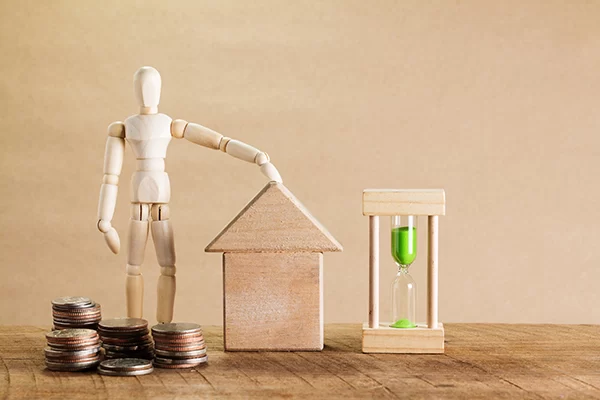Low-cost housing solutions constitute not only sustainable, low-cost choice of materials but also smart and sustainable interior planning and space allocation. There are a range of sustainable materials that can be utilized in low-cost housing which we shall discuss ahead. By simply making smarter decisions when it comes to the planning and structure, utilizing conventional building materials can actually save costs.
Saving Cost on Conventional Building Materials
One key way to save on cement and steel for a house structure is to keep the outer walls the standard thickness but to reduce the interior partition walls’ thickness. For example, outer walls can be a standard 9” while interior walls can be reduced to 4”. This will end up saving a lot of material and therefore cost. To save further costs, it is also possible to use other materials for interior partition walls such as screens of lighter materials like jute or fiber which can be added after construction as per the space allocation. The only solid partition walls would have be around the bathroom in such a design.
Roofing System – Prefab Cement Slabs and Restressed Girders
There are a number of products available in the market in Pakistan currently that are being used to construct low-cost single unit, single-story houses. One such product is for the roofing system which incorporates prefab cement slabs and restressed girders. The slabs come in sizes of 2.5’ x 1.0’’ up to 7.5’ x 1.5’’ while the girders in sizes 4’ x 9’’ up to 8’ x 24’’. First the girders are placed on the outer walls and sealed with a cement mixture, after which the concrete slabs are placed on top of the roof. Their shapes are highly symmetrical and identical so they fit edge to edge. This entire process of roofing completely does away with the need of steel rebar and reinforcement in the roof slab, therefore saves considerable cost. However, such a solution is only suitable for single-storey housing.
Granulated Blast Furnace Slag
When it comes to the saving of the use of steel and cement, a number of pilot projects have been carried out by different organizations that have failed to attract the attention of governmental institutions. The CWHR (Council for Works and House Research) is one such organization that has carried out extensive research on ways to conserve cement and steel use within low-cost housing. Using granulated blast furnace slag as partial replacement of cement in construction, they have been able to construct single storey sturdy and durable structures. Other innovations by CWHR in terms of materiality includes wheat-straw concrete block masonry; wheat straw fibers are mixed with cement (to reduce cement use) where the wheat straw fibre adds strength to the mixture. This type of construction involves wheat straw concrete block masonry for load bearing walls with lightweight R.C.C.
Tile Batten-Roofing system
This type of construction has been proven to be economical with good thermal capabilities. It has been tested out as a means of ‘self-help’ construction in rural areas where inhabitants can easily assemble houses using these materials themselves.
Composite Materials
When it comes to alternative, non-conventional materiality there are a number of composite building materials available locally and that are coming up within developing countries. These involve natural fiber materials with enhanced properties for example fibers like jute and coconut are cheap, readily available and biodegradable/environment friendly. They have the potential to replace plastic fibers used in fiber sheets. Generally, composite building materials have great potential to develop as an industry within construction as they provide durable solutions for housing because they help in reducing corrosion and weight within structures. Other composite materials involve the use of industrial wastes which can be recycled and used to manufacture low-cost portable toilets, water storage tanks, bath tubs, doors and windows. These products are available internationally and can be purchased in bulk by the government and housing society companies to develop low-cost construction within Pakistan.
‘Incremental Building’ Model
A key concept within low-cost housing that has emerged over the past two to three decades is the “incremental building” model. When done right, it has proven to be one of the most efficient ways in cutting down on a housing scheme’s overall execution costs. As the word “incremental” suggests it is to do with making smaller houses that can be added to later depending on the needs of the family. The houses usually can also be delivered in an incomplete stage but ready enough to provide shelter and comfort to the family and then gradually be completed over time by the homeowner themselves. Since housing can positively affect the incomes of people, they can add to the finishes over the house over time as their income increases. This puts less load on the government or housing scheme companies in charge of developing the housing schemes.
European Safe-Box Technology
Landscape PLC is also studying the familiarity of European safe-box technology, to enable quick erection of homes and buildings – prefabricated concrete boxes placed adjacent and on top of each other to create a seamless brilliant finished structure. It involves all electrical HVAC, thermal, insulations, plumbing and other attributes of MEP with a pre-defined conduiting for such cables and water distribution. A turnaround time of 2-3 days for civil construction – like Lego puzzle using cranes to stack and tie at construction site whilst all of the prefabrication of such RCC slabs takes place at the safe-box factory.
A revolutionary approach which might take time to embrace in developing countries however eventually all will lead in this direction.
Photo by Picas Joe from Pexels: https://www.pexels.com/photo/money-for-mortgage-11348119/

